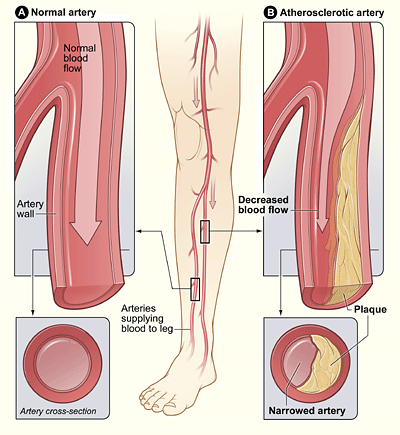
Source link: https://www.ncbi.nlm.nih.gov/books/NBK576430/
A lower extremity arterial duplex ultrasound, also known as a peripheral vascular test, is a non-invasive diagnostic procedure used to evaluate blood flow and detect abnormalities in the arteries of the lower extremities. It is commonly performed to assess for peripheral artery disease (PAD), a condition characterized by narrowing or blockages in the arteries that supply blood to the legs and feet. The test uses ultrasound technology to visualize blood flow and detect any obstructions or abnormalities in the arteries.
Procedure
During a lower extremity arterial duplex ultrasound, the following steps are typically performed:
- Preparation: The patient lies comfortably on an examination table, usually in a supine position. A water-soluble gel is applied to the skin over the area to be examined to facilitate the transmission of sound waves.
- Ultrasound Imaging: A handheld ultrasound transducer, also known as a probe, is placed directly on the skin over the arteries of the lower extremities. The transducer emits high-frequency sound waves that bounce off the blood vessels and surrounding tissues, producing real-time images of the arteries and blood flow on a monitor.
- Doppler Evaluation: In addition to traditional ultrasound imaging, Doppler ultrasound is used to assess blood flow velocity and direction within the arteries. Doppler signals are generated by the movement of red blood cells and are represented graphically on the ultrasound monitor.
- Segmental Pressures: In some cases, segmental blood pressure measurements may be obtained simultaneously with the arterial duplex ultrasound. Blood pressure cuffs are placed on various segments of the legs, and the blood pressure in each segment is measured to assess for pressure gradients and differences between segments.
- D-Rings or Attachment Points: D-rings or attachment points may be included on the life vest to allow the wearer to clip on additional safety equipment, such as a safety tether or rescue line.
- Interpretation: The ultrasound images and Doppler waveforms are interpreted by a trained healthcare provider, usually a vascular technologist or vascular surgeon. Abnormalities such as stenosis (narrowing), occlusions (blockages), or abnormal blood flow patterns may indicate underlying peripheral artery disease.
Indications
Lower extremity arterial duplex ultrasound may be indicated for patients presenting with symptoms suggestive of peripheral artery disease, including:
- Claudication (cramping or pain in the legs with activity)
- Rest pain or ischemic ulcers in the feet or toes
- Absent or diminished pulses in the lower extremities
- Non-healing wounds or ulcers on the legs or feet
- Coldness or discoloration of the legs or feet
- History of smoking, diabetes, hypertension, or other cardiovascular risk factors
Benefits
Lower extremity arterial duplex ultrasound offers several benefits for patients suspected of having peripheral artery disease, including:
- Non-invasive: The procedure is non-invasive and does not require the use of ionizing radiation or contrast agents, making it safe and well-tolerated by most patients.
- Real-time imaging: Ultrasound provides real-time images of the arteries and blood flow, allowing for immediate visualization and interpretation of any abnormalities.
- High sensitivity and specificity: Duplex ultrasound has high sensitivity and specificity for detecting arterial stenosis, occlusions, or other abnormalities, allowing for accurate diagnosis and treatment planning.
- Guided interventions: The information obtained from the arterial duplex ultrasound can guide further diagnostic testing, such as angiography or magnetic resonance angiography (MRA), and help determine the need for revascularization procedures such as angioplasty or stenting.
Limitations
While lower extremity arterial duplex ultrasound is a valuable diagnostic tool for evaluating peripheral artery disease, it has some limitations, including:
- Operator dependence: The quality and accuracy of the ultrasound images depend on the skill and experience of the ultrasound technologist or physician performing the procedure.
- Limited visualization: Ultrasound may have limited penetration in obese patients or in areas with deep-seated arteries, potentially limiting visualization of the entire arterial system.
- Inability to assess small vessels: Ultrasound may not be able to visualize very small or distal arteries in the lower extremities, particularly in patients with severe peripheral artery disease or extensive calcification.
Conclusion
Lower extremity arterial duplex ultrasound is a non-invasive diagnostic test used to evaluate blood flow and detect abnormalities in the arteries of the lower extremities. It plays a crucial role in the diagnosis and management of peripheral artery disease by providing real-time imaging of arterial anatomy and blood flow patterns. With its high sensitivity and specificity, arterial duplex ultrasound helps healthcare providers accurately diagnose peripheral artery disease, assess disease severity, and plan appropriate treatment strategies to improve patient outcomes.
